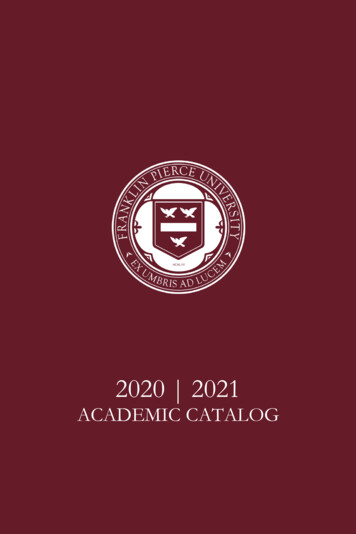
Transcription
222 NORTH 20TH STREETPHILADELPHIA, PA 19103www.fi.eduANNUAL REPORT 2014ANNUAL REPORT 2014ANNUAL REPORT 2014 THE FRANKLIN INSTITUTETHE FRANKLIN INSTITUTE82
DESTINATIONDid you know that BenjaminFranklin’s bifocals (which heinvented) are on display?Learn about other objects in ourcuratorial collection on page 11.02New Doors Open09Conversation with the Karabots11Wonderland of Science13Exhibitions17How Did We Get Inside Your Brain?20Reimagined Sports ChallengeSCIENCE AND TECHNOLOGYHow will climate change affectcities and what can we doabout it? See pages 25 –26.RESEARCH23Partnership Advances Communication24Hamilton Legacy of SupportACTION25Convening Climate Change Partners28Philadelphia Science FestivalEDUCATIONYour brain is always changing—even as you read this sentence.See page 37.29STEM Scholars Graduates First Class31PECO Reaches Students Across the Region32Augmented Reality Project Yields Valuable LessonsPUBLIC ENGAGEMENTEXPANDING REACH35Science After Hours36Rosalind Williams: From the Museum Floor to the Board37Let’s Talk about Your Brain38Sensory-Friendly SundaysCOMMUNITYThe Perelman Shimmer Wall isa kinetic sculpture that is part ofthe new Nicholas and AthenaKarabots Pavilion.See pages 5-12.Your generosity keeps theInstitute’s Heart beating.Thank you.39Professional Learning41Neighborhood ProgrammingLEGACY452014 Franklin Institute Awards47Committee on Science and the Arts50William and Laura Buck Support SportsZoneSUPPORT532014 Financial Statements55Contributed Support
EXECUTIVEMESSAGEDEAR FRIENDS,CURIOSITY. DISCOVERY. INQUIRY. DELIGHT.THESE ARE KEY PARTS OF ANY EXPERIENCETHE FRANKLIN INSTITUTE CREATES.Curiosity. Discovery. Inquiry. Delight. Theseare key parts of any experience The FranklinInstitute creates, whether it’s in one of the 12exhibit galleries in the museum building or in apark, a community center, or your neighborhoodlibrary. In 2014 we expanded our capacity tocreate these experiences onsite by openingthe Nicholas and Athena Karabots Pavilion,the first addition to the Institute’s building inmore than 20 years. Last year the Institutewelcomed 761,557 visitors from around theworld, including 187,751 students, 31,239 fromunderserved schools who visited for free. Intotal, the Institute’s programs across the cityand around the world directly reached 1.1 millionpeople in 2014.As you will read in this report, in thebusy months leading up to and following theKarabots Pavilion opening, we didn’t miss abeat. In addition to celebrating, we continuedand expanded upon our other projects:convening partners, reaching out into thecommunity, and providing learning opportunitiesfor students, families, educators, adults acrossthe region and beyond.The Franklin Institute is an essential part ofthe vibrant city of Philadelphia. As you read inthis report about the learning, creativity, and funthat took place in 2014, please know that yoursupport makes it all possible. Thank you for yourgenerosity to your museum, and for helping usto do more, be more, and inspire more peopleto have a passion for learning about science andtechnology. In the year ahead, we hope you willjoin us again as we help the greater Philadelphiaregion to connect with and explore science innew and exciting ways.Warmest regards,Donald E. Morel, Jr., Ph.D.Larry DubinskiChair, Board of TrusteesPresident and CEOTHE FRANKLIN INSTITUTEANNUAL REPORT 2014Larry Dubinski, pictured leftDon Morel, pictured right12
DESTINATIONNEW DOORS OPENC O N V E R S AT I O N W I T H T H E K A R A B O T SWONDERLAND OF SCIENCEEXHIBITIONS3REIMAGINED SPORTS CHALLENGEANNUAL REPORT 2014THE FRANKLIN INSTITUTEHOW DID WE GET INSIDE YOUR BRAIN4
DESTINATION5SaylorGregg and the Nicholasand Athena Karabots Pavilionwere honored with an awardat the American Institute ofArchitects (AIA) Awards forDesign Excellence.After six years of planning and 18 months ofconstruction, in the second week of June, theNicholas and Athena Karabots Pavilion openedto the public with a week of incredible events.On June 12 a gala celebration welcomed theproject’s most ardent supporters—and therewere many. Chief among them were lead donorsNicholas and Athena Karabots, whose 10 milliongift made it possible to break ground in April 2012(see page 12).On June 14, the Karabots Pavilion openedto the public with a ribbon “exploding” in trueFranklin Institute style, and an entire day ofspecial programs and events, including sciencedemonstrations, living “statues” of FranklinInstitute Award winners, and the knowledge thatPhiladelphia’s science and technology learningresources had just expanded in wonderful ways.ANNUAL REPORT 2014THE FRANKLIN INSTITUTENEW DOORS OPEN6
DESTINATIONThe first 500 visitors were admitted free of charge, and by opening time, aline stretched around the block. The community’s overwhelming responseto the new resources the Nicholas and Athena Karabots Pavilion providescontinues a 190-year tradition (and 80 years on the Parkway) of celebratingscience learning in Philadelphia.Adding 53,000 square feet in a fourth wing on the Institute’s south side,the Nicholas and Athena Karabots Pavilion houses an education center andconference space on its ground floor, the Your Brain exhibit—now theInstitute’s largest exhibit and the largest neuroscience exhibit in the country—and climate-controlled special exhibit space that makes it possible to hostfragile artifacts and larger traveling shows. Your Brain appears in the FrankBaldino, Jr. Gallery and is underwritten by Teva Pharmaceuticals.THE FRANKLIN INSTITUTEAt the Brain Bar, staff and volunteers helpvisitors explore actual brain specimens.7Watch the Emmy Award-winning video 80Years of Discovery, which debuted at theKarabots Pavilion opening gala, on our websiteat www.fi.edu/support-inspire-scienceAn actress playing Franklin AwardLaureate Marie Curie describes discoveringthe elements polonium and radium.ANNUAL REPORT 2014THANKS TO INCREASED CLASSROOM SPACE, DISCOVERY CAMPNEARLY DOUBLED LAST SUMMER TO 1,500 CAMPERS, ANDHUNDREDS MORE STUDENTS AND TEACHERS USED THE NEWSPACES FOR WORKSHOPS AND PROFESSIONAL DEVELOPMENT.8
THE FRANKLIN INSTITUTENICHOLAS AND ATHENA KARABOTS: WHY WE GIVE9When Nicholas and Athena Karabots made a 10million gift to the Inspire Science campaign, theycatapulted the Institute’s ambitions into reality bymaking possible the groundbreaking of the newbuilding that bears their name. A student from theInstitute’s STEM Scholars program, EvangelineAdjei-Danquah, sat down with the Karabots to learnmore about the motivation behind their philanthropy,which impacts many organizations in the region.Nick: Well, Eva, where are you from, andwhat would you like to know about us?Evangeline: I live in South Philly. My father isa teacher, and we moved here from the Bahamaswhen I was three years old. I have two oldersiblings who are both in college at St. Joseph’sUniversity. I’m hoping to study neuroscience incollege, and I’m a junior this year, so I’m preparingto take the ACT exam. I’m interested in learningabout your career—what do you do now and howdid you achieve your success?Nick: I’m the chairman and president of amanagement company that oversees printing,publishing, real estate and other businesses thatemploy about 1,600 people. But looking back to whenI was six years old, I sold calendars during thedepression years of 1939 and 1940. When I was nineI made a shoeshine box and I would travel by subwayto shine shoes in Union Square. My family lived in theSouth Bronx, and I’d bring the money I made hometo my mother. It was a nickel a shine, so I shined alot of shoes during those war years. Through highschool I had jobs at a drugstore, I delivered flowersand newspapers, and after high school I was amailroom runner at a company that had two smallprinting presses, and with the help of the twobrothers that ran them, I too learned to run them.Athena: When we met, I was 19, and when wegot married, Nick got a job at Daitch Crystal Dairies.He ran the small printing department and eventuallywith the help of the owners he learned theprocesses involved in silkscreening and startedthe silkscreen department, which produced largesigns for the Daitch supermarket stores.Nick: It was a wonderful period. Athena wasvery supportive. We had no money, but we lovedeach other, and we needed each other. The nextstep in my career came when someone elsegave me a hand—the owner of a company thatmanufactured mimeograph supplies asked me tomove to Washington, DC to set up a sales office. Hetold me he thought I could do the job, and that gaveme confidence. That’s one of the reasons we do whatwe do—because people helped us along the way.Evangeline: That’s how I discovered STEMScholars as well. My biology teacher recommendedthat I apply for the programbecause she thought Icould do it.Nick: Exactly. It alsohelped that I made my owndecisions and as a resultbelieve that I made my ownluck—but I had to take somechances. When a few of thecompanies I started didn’twork out I did not stop trying.While looking for the nextopportunity I became a daytrader on the stock market,but then saw an opportunity in printing. In 1970 I,together with a friend, bought the ScrantonLithographing Company, which had been establishedin 1906. We printed TV Guide, and we were oneof only a few printing companies in the country tointegrate new Japanese technology that automatedthe TV Guide printing processes. I created goodrelationships with people, and there were severalother times in my career when mentors and peopleI admired trusted me and helped me, and so whenI became successful, giving back to the communityand particularly to those that come from backgroundssuch as mine became very important to me. Youhave to give back.Evangeline: Is that why you decided to makesuch a generous gift to The Franklin Institute?Athena: We visited for the first time and metDerrick Pitts in the Observatory. He was with agroup of young people learning about astronomy,and it was such a thrill to see these kids, whowouldn’t otherwise have this opportunity, getting tolearn from Derrick. We support a group of youngstudents at the College of Physicians, this group isknown as the Karabots Scholars, and we saw theopportunity to create an environment at the Institutewhere even more young people could learn.Nick: In Derrick and The Franklin Institute’sprograms I saw an opportunity. You have toextend your hand to kids and do what you canto encourage them to seek a better life. Youcan show them a little, but you need a guidedprogram that helps them getinto college or a trade. Youdon’t have to give money,but you can give time, givea hand to young people whomight otherwise travel downthe wrong road.Evangeline: I know! I’velearned so much that willhelp me. On science tests Isometimes think, oh, I knowthat answer. I learned thatat the Institute. What otherprojects are you most proud of?Nick: We’re involved at the Children’sHospital of Philadelphia, and donated to theirnew building in West Philly which is an area thatlacked such an institution. People will always findit difficult to pursue their dreams if they are nothealthy. We love the program at the College ofPhysicians, and the new building at the Instituteprovides a great resource for growth for bothkids and adults. And we have our winery here atKaramoor Estates, which we are expanding rightnow, producing and distributing award-winning,Pennsylvania-grown wine which I was told wouldbe difficult to achieve—negative comments Ihave chosen to ignore—and hopefully a lessonfor those youngsters who might be dissuadedfrom reaching for their dream because of thecomments of others.Evangeline: Thank you both so much fortaking the time to talk to me today!ANNUAL REPORT 2014DESTINATION10
DESTINATIONJoseph Priestly’s Orrery,1795 (Cat.#3020)THE FRANKLIN INSTITUTEA WONDERLAND OF SCIENCE11Mystery Clock, ca. 1855.(Cat.#4436) The hour hand ofthis clock appears to float likemagic within the crystal face,unconnected to any visiblependulum, gears, or othermechanism.The Franklin Institute first opened its museumbuilding in 1934, calling it a “Wonderland ofScience.” To celebrate the Karabots Pavilion and80 years on the Parkway, at the public openingof the new building, guests were treated toa display of 80 rarely seen historical artifactsfrom the Institute’s curatorial collections, whichare comprised of more than 3,000 objectsand 40,000 documents. Staff and volunteersselected objects from the collections thatinterested them and learned about their historyso they could share it with visitors. Instead ofbeing behind glass, the objects were on tableswhere they could be closely examined—verycarefully, of course.Objects in the Wonderland of Science exhibitincluded local artifacts, such as a cross-sectionof a water main made of a cored tree trunkunearthed from beneath Chestnut Street,and a wide range of other fascinating artifactsand inventions including patent model for achromatic printing press, a vacuum tube froman early television, telescopes, clocks, andmuch more. The Institute has been awarded aplanning grant from the National Endowmentfor the Humanities to explore how to organizeits collections in different ways with the goal ofdisplaying far more of the treasures in the vaults,and giving the public better access to theseincredible artifacts of scientific creation.Joseph Priestly’s Orrery, 1795 (Cat.#3020)depicted above left. Throughout the 18th and19th centuries, itinerant lecturers, collegeprofessors, and even the dissenting clergyman/natural philosopher/chemist Joseph Priestly(1733–1894), celebrated Nicholas Copernicus’(1473–1543) theoretical heliocentric cosmologyof the universe by using large-scale orreries.From the 18th century to the present, orrerieshave played a fundamental role in entertaining,as well as educating, the general public about thephysical motion of the sun, moon, and planets.Benjamin Franklin’s Holograph Last Willand Testament of 1757 (Cat.#49-15), depictedabove, executed entirely in Franklin’s hand,as attested by him in his own memorandum,in New York on April 28, 1757. Officialpresentation of the will took place on April20, 1949 at the celebration of the 125thAnniversary of the founding of The FranklinInstitute.Lamp, Limelight, ca.1825 (Cat.#63-26)depicted below. A small ingot of quicklime(calcium oxide) is heated by an oxygen/hydrogen flame to above 4,000 degreesFahrenheit, at which temperature it producesan intense white illumination. The gases arecombined at a nozzle aimed at the quicklime,whose position can be adjusted remotely. Suchlights were commonly used in theaters andoutdoors in the mid-19th century and later andgave rise to the expression “in the limelight” todescribe someone in the public eye.Lamp, Limelight, ca.1825(Cat.#63-26) The Limelight Lampis one of more than 3,000 objectsand 40,000 documents in theInstitute’s curatorial collections.ANNUAL REPORT 2014“I love working at an institution with such arich history. It makes me so proud getting toshare with others the artifacts we’re luckyenough to house.” -Institute staff member12
ONE DAY IN POMPEIIEXHIBITIONS2014 began with the final months of OneDay in Pompeii, transporting visitors backto ancient times and the eruption of MountVesuvius that destroyed the city but leftremarkable artifacts behind. One Day inPompeii was sponsored by the Institute’sProud Corporate Partner, PECO.101 INVENTIONSCIRCUS!THE FRANKLIN INSTITUTEIn addition to Your Brain, two other exhibitsentertained audiences throughout the summer,free with general admission. Circus! ScienceUnder the Big Top filled the new climatecontrolled special exhibit gallery in the Nicholasand Athena Karabots Pavilion with color and fun.Visitors could walk a tightrope and try out theiracrobatic skills, and learn about the physics oflaunching a cannonball, the history of the circus,and much more. Circus! was sponsored by theInstitute’s Proud Corporate Partner, PECO.13THE BODYIn October, two exhibits about the body opened:Body Worlds: Animal Inside Out and SesameStreet Presents: The Body. Body Worldsdemonstrated through incredible preservedspecimens how intricate the blood vessels ofanimals are, what the muscular system, bodyparts, and various organs of different animalslook like, and how they compare to otheranimals as well as to human bodies. SesameStreet created a fun environment for youngerchildren to learn about healthy eating, exercise,and how their bodies work.A human cannonballtravels between 60 and70 miles per hour.OUR GALLERIESDEAD SEA SCROLLSInstitute-produced exhibit Dead Sea Scrolls:Life and Faith in Ancient Times traveled tothe Museum of Science in Boston and tothe Leonardo in Salt Lake City.Two photography exhibits brought beautyand contemplation to the Pendulum Gallerylast year. 50 Greatest Photographs andOcean Soul, both produced by NationalGeographic, gave visitors a view of amazingand sometimes troubling moments on landand underwater around the globe.Koalas and primates(including humans) arethe only species withunique fingerprints.YOUR BRAINTurn the page to see details on our excitingnew Your Brain exhibit!ANNUAL REPORT 201430 of the inventions featured in101 Inventions101 Inventions That Changed the World tookover the Mandell Center with enormous screensthat displayed a complex choreography ofgraphics. From contained fire to the computerand the atomic bomb, the exhibit explored theworld’s most remarkable inventions in a dynamicvideo show. 101 Inventions was sponsored byTE Connectivity.14
DESTINATION“IT’S AWESOME THAT YOU CAN PRETENDTO CLIMB THROUGH THE BRAIN AND SEEHOW IT SENDS MESSAGES TO OTHERPARTS OF THE BODY.” -Jack, age 8THE NEURAL CLIMBis more than just fun—it’s a representation of how our brainscommunicate. Challenged with representing this essential organ,exhibit designers thought about how they could best help visitorsunderstand what it might look like as a neuron—a tiny cell in thebrain—that sends electrical and chemical signals. Since Your Brainopened in June, the Neural Climb has been full of visitors of all ages,the exhibit. The largest neuroscience-focused exhibit in the country,Your Brain explores how our brains continue to change every day,and throughout our lifetimes. From the physiology of the brain, tohow we make sense of the world around us, to ethical questionsabout neuroscience research, visitors learn about how amazingtheir own brains really are. Your Brain appears in the Frank Baldino,Jr. Gallery of the Nicholas and Athena Karabots Pavilion and isANNUAL REPORT 2014THE FRANKLIN INSTITUTEwho also can explore more than 70 other interactive experiences insponsored by Teva Pharmaceuticals.1516
HOW DID WE GET INSIDE YOUR BRAIN?17THE EXHIBIT DREW ON ARTIFACTS, SCIENTIFIC DATA,PHYSICAL MODELS, AND DIGITAL TOOLS TO CREATE ACOLLECTION OF MULTISENSORY EXPERIENCES.The Your Brain Exhibit Design Team“The exhibition is created as a series of sixsmaller galleries where the design dramaticallychanges as the narrative unfolds, allowing thedesign to play a major role in communicatingthe content,” explains Director of Exhibits andDesign Jeanne Maier. In Your Brain, each galleryphysically immerses visitors in learning aboutthe brain through dramatic environments createdwith lighting, sound, color, and graphics. Forexample, lighting in some galleries is darkenedto evoke the feeling of being inside the brain,while others are brightly lit like the world aroundyou. Graphic design was inspired by scientificvisualizations of the brain, using bright pops of colorto draw attention to key information. The finalexhibit was then fabricated to withstand millionsof eager visitors over its lifespan.The many ways Your Brain engages visitorsall contribute to its central story—your brain isalways changing, even right here, right now,in this exhibit. As visitors examine any singlespecimen or experience, this bold premiseinvites them to also examine themselves.ANNUAL REPORT 2014THE FRANKLIN INSTITUTEYour brain creates the entire world around you, yet the mechanisms bywhich it works are invisible to the human eye. So how did the Institute’sexhibit design team create an 8,500-square-foot exhibition about brain sciencewith 70 hands-on interactive experiences?Charged with the task of creating a cohesive storyline about a continuouslyexpanding yet largely unsolved field of science, Chief Bioscientist JayatriDas looked to points of intersection between popular science and primaryresearch. “We decided to follow the story of your brain because we couldtackle a broad range of topics while making it relevant to you at every step,”says Das. “What is the brain? How does it help us process the world?Where will—or should—brain research take us in the future?”Collaborating with a scientific advisory board, the in-house team begandeveloping interactive experiences to communicate core science content.Recognizing the rapidly changing nature of the science, many deviceswere built to demonstrate timeless phenomena whose explanationscan be updated as science progresses. The exhibit drew on specimens,scientific data, physical models, and digital tools to create a collectionof multisensory experiences. Each device was evaluated with visitors,testing whether it was intuitive to use, conveyed the correct content, anddelivered a fun interaction.18
DESTINATIONStand andJumpRun and JumpAll prototypes start with a sketchand a storyboard before theprototypers build the actual sampleinteractive.A REIMAGINED SPORTS CHALLENGE19Test your speed against yourfriends and professionalathletes in the Athletes inAction interactive.of a professional athlete racing down the lengthof the track, and a new pitching cage thatdemonstrates the mechanics of throwing a greatpitch. Designing a great exhibit from conceptto reality is a complex process that not manymuseums are able to do in-house. Next time youvisit the Institute, you might be asked to test outa new device under development—and becomepart of science education in the making!DESIGNING A GREAT EXHIBIT FROMCONCEPT TO REALITY IS A COMPLEXPROCESS THAT NOT MANY MUSEUMSARE ABLE TO DO IN-HOUSE.The new SportsZone exhibit is madepossible by the generous support of JamesMaguire, Jr., the Maguire Family Foundation,and Philadelphia Insurance Companies, and byWilliam and Laura Buck, Ernest and RobertaScheller, and the Dow Chemical Company.ANNUAL REPORT 2014THE FRANKLIN INSTITUTEOne of the most popular exhibits at the Institute,Sports Challenge has welcomed millions ofvisitors—and even more hands and feet kicking,throwing, and jumping—over the last 15 years.Its beloved interactive experiences were duefor an update, and a completely new exhibitrenamed SportsZone will open in October 2015.In reimagining how to engage audiences in anew way, the Institute’s Exhibit Design Teamtested a number of ideas as prototypes beforechoosing a final set of experiences that willeducate, entertain, and stand up to the crowds!One winner was the Jump Momentum, whichinvestigates the question: why can you jumphigher when you get a running start? The exhibitdesigners built a model of the Jump Momentuminteractive out of lights, switches, plywood, andbasketballs and asked museum visitors to testit. The final design guides visitors to learn howthe extra momentum from a running start helpsyou jump a few inches higher. Other interactivesin the new exhibit include a 40-foot run wherevisitors can test their speed against the projection20
SCIENCE ANDTECHNOLOGYRESEARCHACTIONTHE FRANKLIN INSTITUTEANNUAL REPORT 2014E D U C AT I O N2122
RESEARCHFrom left: MattHamilton, DorranceHamilton Benson,Anne Hamilton,Daniel M. BensonHOW DOES IT WORK?:PARTNERSHIP ADVANCES COMMUNICATIONABOUT SCIENTIFIC RESEARCHDr. Jayatri Das, help the researchers to explainthese concepts in ways that are meaningful to thepublic. The team then distributes activity kits thatpackage these explanations to 16 other museumsaround the country.The Evan Pugh Professor of Chemistry,Physics, Biochemistry and Molecular Biology atPenn State, Dr. TomMallouk, reports: “Ourongoing collaborationand partnershipwith The FranklinInstitute has beenboth a pleasure andan inspiration forboth myself and fornumerous students, postdocs and other facultyin the Center including how to distribute theproducts of our collaborative efforts to a broaderaudience (including a network of other museums).As noted by a visiting NSF Advisory Committeemember, ‘The work with The Franklin Instituterepresents impressive national visibility.’”THE FRANKLIN INSTITUTETHE PARTNERSHIP’S LATEST THEMEILLUMINATES THE SCIENCE OF MOBILECOMMUNICATIONS. VISITORS GET TOSEE ANTENNAS, TRANSMITTERS, ANDRECEIVERS AT WORK.23An activity about touchscreens illustrates how thecoordinates of your input aremapped onto an invisible grid.S. MATTHEWS V. HAMILTON, JR.AND THE HAMILTON FAMILY FOUNDATIONMatt Hamilton’s and his family’s legacy ofgiving and service to The Franklin Institutedates back to 1933, when Mr. Hamilton’s greatgrandfather Samuel M. Vauclain donated theBaldwin 60000 locomotive. Vauclain was thePresident and later Chairman of the Board ofBaldwin Locomotive Works. He was awarded theJohn Scott Award for his invention of wroughtiron wheel centers, and the Elliott Cresson Medalfor his invention of the compound locomotiveby The Franklin Institute in 1891. When theBaldwin 60000 was delivered, tracks were builtleading into the Institute’s new building, and thendismantled outside. A wall sealed the locomotivein, and it has rested there ever since—thecenterpiece of The Train Factory exhibit.When Matt Hamilton was a child, he visitedthe Institute with his parents, and enjoyed spendingtime with his great-grandfather’s train. Later, hejoined the Board of Trustees, where he servedfrom 1993–2014. Mr. Hamilton explains, “Ialways loved science and nature, so it was aneasy draw to get me involved. My wife Anne andI were just starting our family, and I know thatthe Institute is a great educational resource inthe area to get young minds exposed to science,from flight, to electricity, to the heart, and nowthe brain.” They brought their own children tothe Institute, and they continue to visit today.“On the Board, I fully supported the decision inthe ‘90s to renovate all the exhibits,” Mr. Hamiltonremembers. “They were old and tired and neededto be updated, and some new ones added—thatwas a great thing to see and be part of.”The Hamilton Family and the Foundation havesupported many projects at the Institute over theyears, including generous gifts from Mr. Hamilton’sparents, Samuel M.V. and Dorrance Hamilton,for the Benefactor Society and for each of theInstitute’s major campaigns, including fundingthe Changing Earth exhibit. Most recently theFoundation made a three-year commitmentin support of youth education programs at theInstitute. Mr. Hamilton explains, “The missionof the Hamilton Family Foundation is to givedisadvantaged youth exposure to experiencesthat they wouldn’t see otherwise, with hopethat this will spark something in their mindsand inspire them in ways that will help themhave bright futures.” As PACTS and STEMScholars students graduate from high school andcontinue to college, this inspiration has clearlycontributed to their success.As philanthropic leaders in the region, Matt andAnne Hamilton, who are both very involved on anumber of nonprofit boards, have set a standardfor philanthropic activity and giving in the greaterPhiladelphia region. Mr. Hamilton explains, “Wewere taught that when you have, you give back,and we’ve tried to instill that in our children. Theyare beginning to become involved and know thattheir turn will come to step up. This is what thenext generation needs to do.” Last winter, Mr. andMrs. Hamilton co-hosted an Institute event in PalmBeach, along with Marsha and Jeffrey Perelman andToni and Bob Garrison. Mr. Hamilton remembers,“Derrick Pitts came to help us look at the stars,and one of my favorite constellations has alwaysbeen Orion. With Derrick’s help, I was able to seethat of the three stars hanging below Orion’s Belt,the middle one is an enormous gas cloud wherenew stars are being born. That was fascinating.Derrick is a brilliant guy who talks on a layperson’slevel and makes things easy to understand. TheInstitute is an anchor on the Parkway, but it’s alsoa great cultural institution. It teaches everybodyabout how things work in our world.”ANNUAL REPORT 2014Not long ago, being able to call anyone in thecountry (or even the world) from the sideline ofa sporting event was inconceivable, but nowwe accept that these little boxes can and willconnect us quickly and reliably no matter wherewe are. How does your smartphone work? Apartnership between The Franklin Institute andthe Penn State Centerfor Nanoscale Scienceaims to answer thisand other questions.Since 2000, thispartnership has beenproducing activity kits tohelp people understandmaterials science—thefundamental workings of our everyday toolsthat most of us take for granted. Through thisNational Science Foundation (NSF)-funded project,scientists at Penn State research nanoscalematerials, including their use in alternative energy,nanotechnology, and other topics. Institutepresenters and scientists, led by Chief BioscientistThe Baldwin 60000approaching theInstitute.24
CONVENING CLIMATE CHANGEPARTNERSTHE FRANKLIN INSTITUTEAT THE PHILADELPHIA COMMUNITY OFPRACTICE KICKOFF MEETING, ORGANIZATIONSCONVENED TO DISCUSS CLIMATE CHANGEEDUCATION IN URBAN AREAS.25The Climate and Urban Systems Partnership(CUSP) is a major grant awarded in 2012 to TheFranklin Institute as lead facilitator and to fiveother organizations by the National ScienceFoundation to conduct a five-year educationresearch and development project on creatingan effective model for learning about climatechange impacts and solutions in cities. In thepast two years, the Institute has convenedpartners from Philadelphia, New York,Pittsburgh, and Washington, D.C. to createprojects that will help people prepare to live inhotter, wetter urb
THE FRANKLIN INSTITUTE 9 ANNUAL REPORT 2014 10 DESTINATION When Nicholas and Athena Karabots made a 10 million gift to the Inspire Science campaign, they catapulted the Institute's ambitions into reality by making possible the groundbreaking of the new building that bears their name. A student from the Institute's STEM Scholars program .










